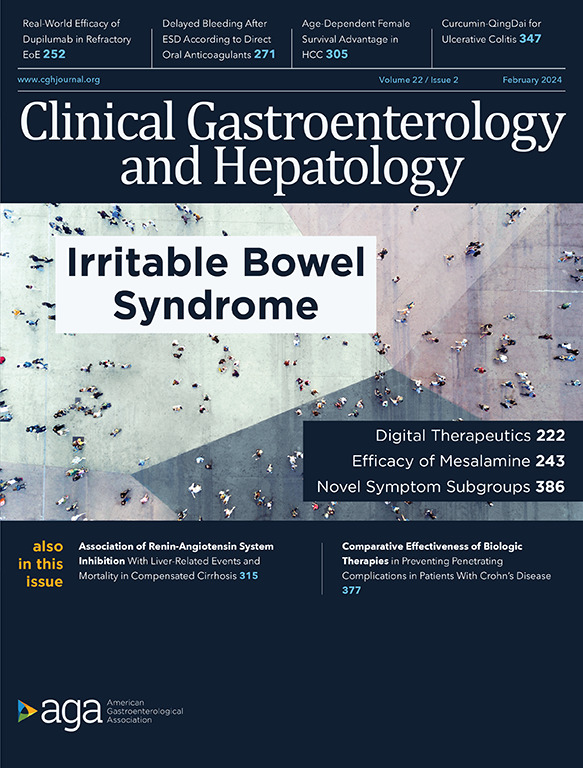粪便免疫化学检验法筛查结直肠癌的危害效益比(考虑到之前的粪便血红蛋白浓度)。
IF 11.6
1区 医学
Q1 GASTROENTEROLOGY & HEPATOLOGY
引用次数: 0
摘要
背景和目的:本研究旨在为基于粪便免疫化学检验(FIT)的结直肠癌(CRC)筛查提供证据,以筛查所需人数(NNS)和范围所需人数(NNSc)来反映之前粪便血红蛋白(f-Hb)的浓度:方法:研究对象包括参加荷兰 CRC 筛查计划最多四轮 FIT 筛查的参与者。本研究的主要结果是根据先前的 f-Hb 浓度,在第二、三或四轮筛查中检测出一个 CRC 和/或 AN 的 NNS 和 NNSc。采用卡方检验和逻辑回归对不同参与者的结果进行比较:共有 2,428,883 名研究参与者完成了至少两次连续的 FIT,1,308,684 人完成了三次 FIT,150,958 人完成了四次 FIT。按轮检测的 AN 分别为 31,400 例、16,060 例和 2,007 例。无论哪一轮筛查,有检测到 f-Hb 病史与没有检测到 f-Hb 病史的个体的 NNS 都有显著差异。与可检测到 f-Hb 的人相比,既往 FIT 阴性结果中未检测到 f-Hb 的人检测到一个 AN 的 NNS 几乎是可检测到 f-Hb 的人的 9 倍(OR 8.71,95%CI 8.51-8.92)。NNSc也观察到类似的方向性模式,尽管差异较小(OR 2.7,95%CI 2.7-2.8):结论:基于 FIT 的筛查对未检测到 f-Hb 的个体与之前检测到 f-Hb 的个体的危害效益比要大得多。对于这类低风险人群,应考虑降低筛查强度。本文章由计算机程序翻译,如有差异,请以英文原文为准。

Harm-to-Benefit Ratio of Fecal Immunochemical Test–Based Screening for Colorectal Cancer Given Prior Fecal Hemoglobin Concentrations
Background and Aims
This study aimed to provide evidence on the harm-to-benefit ratio of fecal immunochemical test (FIT)–based colorectal cancer (CRC) screening by previous fecal hemoglobin (f-Hb) concentrations, as reflected in the number needed to screen (NNS) and number needed to scope (NNSc).
Methods
Participants in up to 4 FIT screening rounds of the Dutch CRC screening program were included. The main outcomes of this study were the NNS and NNSc to detect 1 CRC and/or advanced neoplasia (AN) in screening rounds 2, 3, or 4, conditional on previous f-Hb concentrations. Outcomes were compared between participants using chi-square tests and logistic regression.
Results
In total, 2,428,883 study participants completed at least 2 consecutive FITs, 1,308,684 completed 3 FITs, and 150,958 completed 4 FITs. There were 31,400, 16,060, and 2007 ANs detected by round, respectively. The NNS for individuals with vs without a history of detectable f-Hb differed significantly irrespective of screening round. Individuals without detectable f-Hb in previous negative FITs had almost 9 times the NNS to detect 1 AN compared with those with detectable f-Hb (odds ratio, 8.71; 95% confidence interval, 8.51–8.92). A similar directional pattern was observed for NNSc, although the differences were smaller (odds ratio, 2.7; 95% confidence interval, 2.7–2.8).
Conclusions
The harm-to-benefit ratio of FIT-based screening is substantially greater in individuals without vs with prior detectable f-Hb. Less intensive screening should be considered for this lower-risk group.
求助全文
通过发布文献求助,成功后即可免费获取论文全文。
去求助
来源期刊
CiteScore
16.90
自引率
4.80%
发文量
903
审稿时长
22 days
期刊介绍:
Clinical Gastroenterology and Hepatology (CGH) is dedicated to offering readers a comprehensive exploration of themes in clinical gastroenterology and hepatology. Encompassing diagnostic, endoscopic, interventional, and therapeutic advances, the journal covers areas such as cancer, inflammatory diseases, functional gastrointestinal disorders, nutrition, absorption, and secretion.
As a peer-reviewed publication, CGH features original articles and scholarly reviews, ensuring immediate relevance to the practice of gastroenterology and hepatology. Beyond peer-reviewed content, the journal includes invited key reviews and articles on endoscopy/practice-based technology, health-care policy, and practice management. Multimedia elements, including images, video abstracts, and podcasts, enhance the reader's experience. CGH remains actively engaged with its audience through updates and commentary shared via platforms such as Facebook and Twitter.

 求助内容:
求助内容: 应助结果提醒方式:
应助结果提醒方式:


